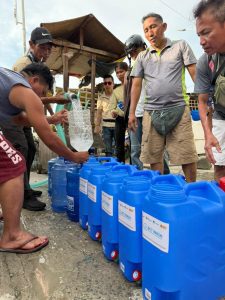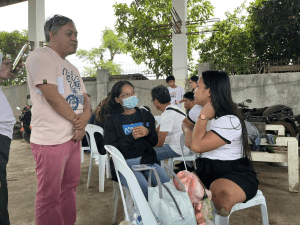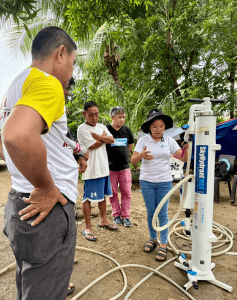
On the night of 30 September 2025, at 9:59 p.m. local time, a magnitude 6.9 earthquake struck offshore Cebu, the Philippines. The epicentre was located approximately 19 km northeast of Bogo City at a shallow depth of five kilometres. The strong quake caused widespread damage to buildings and infrastructure, with the most severe impacts reported in Daanbantayan, Bogo City, Medellin, San Remigio, Tabuelan, and Cebu City. The province of Cebu and 53 other cities and municipalities have declared a state of calamity (ACCESS Consortium Situation Report, 7 October 2025).
According to the DOST-PHIVOLCS (the Department of Science and Technology – Philippine Institute of Volcanology and Seismology), the earthquake was caused by movement along the newly identified Bogo Bay Fault. Since the main event, 6,360 aftershocks have been recorded, with magnitudes ranging from 1.0 to 5.1. While most aftershocks were minor, they have raised serious concerns about the stability of already damaged structures and the safety of affected communities.
As of 6 October, the National Disaster Risk Reduction and Management Council (NDRRMC) reported that 155,094 families (547,394 individuals) across 205 barangays were affected by the earthquake. Of this number, 7,762 families (18,912 individuals) remain displaced — some are staying in evacuation centres while others are sheltering elsewhere.
The earthquake has also caused major disruptions to critical services:
- Power: 91 municipalities experienced power interruptions. While some areas have been reconnected, 48 municipalities remain without power.
- Water: 8 cities and municipalities were affected, and 2 are still waiting for water supply restoration. Access to safe drinking water remains one of the most urgent needs.
- Telecommunications: 10 municipalities are still without mobile and data services.
- Health Services: Hospitals and rural health units have been overwhelmed by trauma cases and have faced capacity challenges due to damaged buildings and continuing aftershocks. There are shortages of essential medicines, surgical kits, and medical staff.
Based on the ACCESS Consortium’s Nexus Tracker Potential Impact Dashboard, the earthquake could affect an estimated 1.69 million people in total. Around 95,810 individuals may face displacement, while 239,410 people are assessed to need immediate humanitarian assistance. An estimated 113,010 people are at risk of losing access to clean drinking water. Importantly, about 58,780 individuals with moderate to severe functional difficulties are considered especially vulnerable, underscoring the urgent need for an inclusive and accessible humanitarian response.
Arbeiter-Samariter-Bund South and South-East Asia (ASB S-SEA) Emergency Response Team (ERT) and our partners in the Philippines, ACCORD Incorporated and A2D Project – Research Group for Alternatives to Development, immediately mobilised to respond:
- 2 October: A joint team from ACCORD and A2D conducted rapid needs assessments, including interviews with persons with disabilities. Immediate gaps identified included a lack of access to safe drinking water, sleeping mats, and water storage facilities during rationing.

- 3 October: ACCORD deployed one pre-positioned Skyhydrant water ultrafiltration unit and stockpiles of WASH items from its Leyte branch office.
- 4 October: 200 earthquake-affected households in Barangay San Vicente, Bogo, received hygiene and water kits through the ECT WASH project (Climate-sensitive WASH project implemented by ACCORD since 2023)
- 7 October: ASB S-SEA ERT held a coordination call to plan further deployments. A2D members began on-the-job training with ACCORD to set up the Skyhydrant, utilising ASB’s rapid assessment guidance, which incorporated the Humanitarian Disability Needs Estimation Tool (HD-NEST) three core questions to ensure the inclusion of persons with disabilities in response planning.
- 8 October: ACCORD demonstrated the installation of the Skyhydrant to A2D and local residents in another affected community. Plans were made to connect the unit to a dug well, which is expected to supply safe drinking water for approximately 250 people in Sub-Village Rosal Azzul, Gaeran Barangay, Bogo City. However, since no motor pump was available in the immediate area, the team is sourcing one from a nearby location to complete the installation. In the meantime, they are also exploring alternative setups, such as using filtered water tanks filled through water trucking provided by other humanitarian actors or rainwater harvesting, which can then be filtered through the Skyhydrant. These options will help ensure the community has reliable access to safe, filtered drinking water.
- 9 October: ASB S-SEA ERT conducted a coordination meeting with ACCORD and A2D to update on the situation, based on observations and rapid assessments by the response team. This coordination ensures the Skyhydrant setup plan matches the visual design support from ASB S-SEA ERT to the ACCORD and A2D teams. It involves gathering initial data for the WASH service targets. ASB S-SEA ERT will give remote assistance to provide projection data for WASH and shelter needs in the response area. Following this, ACCORD and A2D will verify the data and develop a response programme plan.

Based on ASB S-SEA’s experience, the Skyhydrant is crucial in emergencies because it does not require electricity or chemicals, making it ideal for areas with disrupted utilities. With one unit capable of producing up to 10,000 litres of safe drinking water per day, this approach helps reduce reliance on bottled water, lowers energy consumption for boiling, and provides a sustainable solution for communities while infrastructure is being restored.
Our partners are actively responding on the ground — ensuring that no one is left behind, including persons with disabilities and other at-risk groups. However, the situation in affected areas remains fluid and continues to evolve. Power and water networks are still being restored, and coordination between government and humanitarian actors is ongoing.
We express our solidarity with the people of Cebu and extend our heartfelt sympathies to those impacted. In collaboration with our partners, we shall persist in supporting life-saving initiatives and promoting inclusive, community-driven recovery.
#Philippines #CebuEarthquake #DisasterResponse #InclusiveResponse #ASB #A2D #ACCORD #ACCESSConsortium #NoOneLeftBehind


